Mangifera indica
Mangifera indica, commonly known as mango, is a species of flowering plant in the sumac and poison ivy family Anacardiaceae. It is native to the Indian subcontinent where it is indigenous. Hundreds of cultivated varieties have been introduced to other warm regions of the world. It is a large fruit-tree, capable of growing to a height and crown width of about 30 metres (100 ft) and trunk circumference of more than 3.7 metres (12 ft).[3]
| Mangifera indica | |
|---|---|
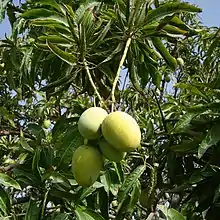 | |
| Scientific classification | |
| Kingdom: | Plantae |
| Clade: | Tracheophytes |
| Clade: | Angiosperms |
| Clade: | Eudicots |
| Clade: | Rosids |
| Order: | Sapindales |
| Family: | Anacardiaceae |
| Genus: | Mangifera |
| Species: | M. indica |
| Binomial name | |
| Mangifera indica | |
| Synonyms[2] | |
| |
The species domestication is attributed to India around 2000 BCE.[4] Mango was brought to East Asia around 400–500 BCE, in the 15th century to the Philippines, and in the 16th century to Africa and Brazil by Portuguese explorers.[5] The species was assessed and first named in botanical nomenclature by Linnaeus in 1753.[6] Mango is the national fruit of India, Pakistan and the Philippines and the national tree of Bangladesh.[7]
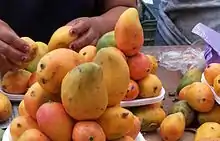
Description
Tree
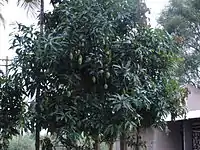
A large green tree, valued mainly for its fruits, both green and ripe. Approximately 210 varieties of mango have been reported. It can grow up to 15–30 metres (49–98 ft) tall. The tree grows best in well-drained sandy loam; it does not grow well in heavy wet soils. The optimal pH of the soil should be between 5.2 and 7.5.[8]
Flowers
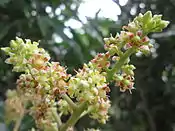
Flowers appear at the end of winter and beginning of spring. Both male and female flowers are borne on same tree. The Climatic conditions have significant influence on the time of flowering of mango. In India, flowering starts in December in the South, in January in Bihar and Bengal, in February in eastern Uttar Pradesh, and in February–March in northern India. The duration of flowering is 20–25 days in Dashehari, while panicle emergence occurs in early December and flower opening is completed by February. The Neelum variety of mango produces two crops a year in Kanyakumari, in South India, but it flowers only once in North Indian conditions[9]
Fruits

The mango is an irregular, egg-shaped fruit which is a fleshy drupe. Mangos are typically 8–12 cm (3–5 in) long and greenish yellow in color. The fruits can be round, oval, heart, or kidney shaped. Mango fruits are green when they are unripe. The interior flesh is bright orange and soft with a large, flat pit in the middle.[10] Mangos are mature in April and May. Raw mangos can be used in the making of pickles and chutneys. Ripe mangos are a popular fruit throughout the world. The skin and pulp account for 85% of the mango's weight, and the remaining 15% comes from the stone (seed).[11]
Chemical constituents

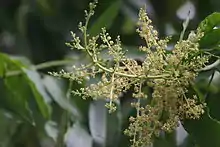
Mangiferin (a pharmacologically active hydroxylated xanthone C-glycoside) is extracted from mango at high concentrations from the young leaves (172 g/kg), bark (107 g/kg), and from old leaves (94 g/kg).[12] Allergenic urushiols are present in the fruit peel and can trigger contact dermatitis in sensitised individuals. This reaction is more likely to occur in people who have been exposed to other plants from the family Anacardiaceae, such as poison oak and poison ivy, which are widespread in the United States.[13]
Traditional medicine
In Ayurveda, it is used in a Rasayana formula sometimes with other mild sours and shatavari (Asparagus racemosus) and guduchi (Tinospora cordifolia). In traditional medicine, varied properties are attributed to different parts of the mango tree.[14]
Wood
The tree is more known for its fruit rather than for its timber. However, mango trees can be converted to lumber once their fruit bearing lifespan has finished. The wood is susceptible to damage from fungi and insects.[15] The wood is used for musical instruments such as ukuleles,[15] plywood and low-cost furniture.[16] The wood is also known to produce phenolic substances that can cause contact dermatitis.[17]
Gallery
 Young mango tree
Young mango tree Mature mango tree
Mature mango tree Tree in Hallandale Beach, Florida
Tree in Hallandale Beach, Florida 110 years ancient mango tree of Gopalganj, Bangladesh
110 years ancient mango tree of Gopalganj, Bangladesh
Mango varieties
References
- World Conservation Monitoring Centre (1998). "Mangifera indica". IUCN Red List of Threatened Species. 1998: e.T31389A9624842. Retrieved 23 July 2020.
- "Mangifera". Plants of the World Online. Royal Botanic Gardens, Kew. Retrieved 8 May 2020.
- "USDA Plant guide, Mangifera indica L." (PDF).
- Sauer, Jonathan D. (1993). Historical geography of crop plants : a select roster. Boca Raton u.a.: CRC Press. p. 17. ISBN 0849389011.
- Gepts, P. (n.d.). "PLB143: Crop of the Day: Mango, Mangifera indica". The evolution of crop plants. Dept. of Plant Sciences, Sect. of Crop & Ecosystem Sciences, University of California, Davis. Archived from the original on December 6, 2013. Retrieved October 8, 2009.
- "Mangifera indica". Germplasm Resources Information Network (GRIN). Agricultural Research Service (ARS), United States Department of Agriculture (USDA). Retrieved October 8, 2009.
- "Mango tree, national tree". 15 November 2010. Retrieved 16 November 2013.
- Flowers of India
- Flowering of mango
- "Mango", Purdue University
- SEA Hand Book 2009, Solvent Extractors' Association Of India
- Barreto J.C.; Trevisan M.T.S.; Hull W.E.; Erben G.; De Brito E.S.; Pfundstein B.; Würtele G.; Spiegelhalder B.; Owen R.W. (2008). "Characterization and quantitation of polyphenolic compounds in bark, kernel, leaves, and peel of mango (Mangifera indica L.)". Journal of Agricultural and Food Chemistry. 56 (14): 5599–5610. doi:10.1021/jf800738r. PMID 18558692.
- Urushiol CASRN: 53237-59-5 TOXNET (Toxicology Data Network) NLM (NIH). Retrieved 22 January 2014.
- Shah, K. A.; Patel, M. B.; Patel, R. J.; Parmar, P. K. (2010). "Mangifera Indica (Mango)". Pharmacognosy Reviews. 4 (7): 42–48. doi:10.4103/0973-7847.65325. PMC 3249901. PMID 22228940.
- "Mango". The Wood Database. Retrieved 30 August 2014.
- "Economic importance of Mangifera indica". Green Clean Guide. Archived from the original on 7 February 2015. Retrieved 30 August 2014.
- Tu, series editor, Anthony T. (1983). Handbook of natural toxins. New York: Dekker. p. 425. ISBN 0824718933.
Further reading
- Litz, Richard E. (ed. 2009). The Mango: Botany, Production and Uses (2nd edition). CABI. ISBN 978-1-84593-489-7
External links
| Wikimedia Commons has media related to Mangifera indica. |
| Wikispecies has information related to Mangifera indica. |
| Wikibooks Cookbook has a recipe/module on |
- Crop of the Day: Mango, Mangifera indica has a list of helpful resources about this species.
